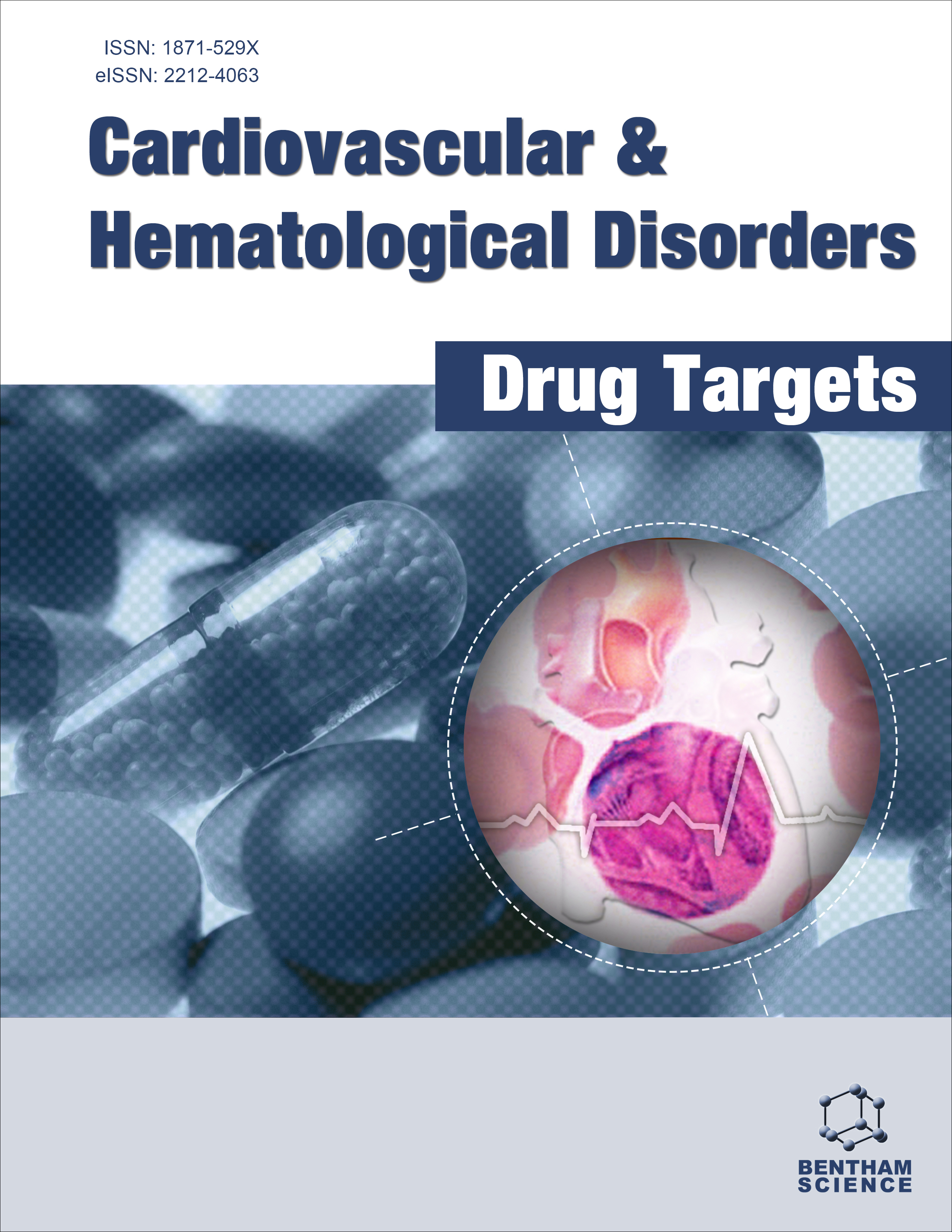- Home
- A-Z Publications
- Cardiovascular & Haematological Disorders - Drug Targets
- Previous Issues
- Volume 13, Issue 2, 2013
Cardiovascular & Haematological Disorders - Drug Targets - Volume 13, Issue 2, 2013
Volume 13, Issue 2, 2013
-
-
Augmentation Therapy with Alpha1-antitrypsin: Novel Perspectives
More LessAuthors: Janciauskiene Sabina and Welte TobiasSERPINA1, α-antitrypsin (AAT) is an acute phase protein, a member of the serpin (serine protease inhibitor) super family and one of the most abundant protease inhibitors in the circulation. The clinical importance of AAT is emphasized in persons with inherited AAT deficiency who exhibit high risk of developing early onset pulmonary emphysema, neonatal hepatitis, liver cirrhosis, which may appear at any age, and in rare Read More
-
-
-
The Serpin Solution; Targeting Thrombotic and Thrombolytic Serine Proteases in Inflammation
More LessSerpins in the mammalian body are highly potent serine protease inhibitors which modulate both thrombotic and thrombolytic pathway activation, with direct and indirect crosstalk with immune and inflammatory pathways. In this review, we discuss mammalian and viral serpins as regulators of coagulation and inflammation. We focus first on the thrombotic and thrombolytic serine proteases and known interactions between thes Read More
-
-
-
Anti-apoptotic Serpins as Therapeutics in Cardiovascular Diseases
More LessAuthors: Johan Kuiper, Paul H.A. Quax and Ilze BotAcute cardiovascular syndromes such as myocardial infarction and stroke are a major cause of death in the Western society and are generally caused by rupture of an atherosclerotic plaque. Treatment of atherosclerosis, the main underlying cause of acute cardiovascular syndromes, is still inadequate for most of the patients. Therefore, there is a need for new therapeutic strategies in addition to the existing lipid-lowering dr Read More
-
-
-
Serpins for Diagnosis and Therapy in Cancer
More LessAuthors: Donghang Zheng, Hao Chen, Jennifer Davids, Marsha Bryant and Alexandra LucasSerine protease inhibitors (Serpins) play an important role in regulating a wide array of diverse biological activities, representing up to 2-10% of circulating plasma proteins. The serpin suicide inhibitors regulate coagulation (thrombosis and thrombolysis), neurotrophic factors, hormone transport, complement and inflammation, angiogenesis, hormone transport, and blood pressure among many other biological reactions Read More
-
-
-
Evaluation of B Lymphocyte Deficiencies
More LessAuthors: John D. Vickery, Christie F. Michael and D. Betty LewThe most common of the primary immunodeficiency diseases are those that involve inadequate antibody production. The characteristic presentation of these disorders is recurrent sinopulmonary infections. An arrest in B cell development at the pre-B cell stage leads to agammaglobulinemia and an insignificant number of B cells. X-linked agammaglobulinemia is the most common of these developmental Read More
-
-
-
Plasminogen Activator Inhibitor with Very Long Half-life (VLHL PAI-1) can Reduce Bleeding in PAI-1-deficient Patients
More LessAuthors: Jerzy Jankun and Ewa Skrzypczak-JankunThis review summarizes our current knowledge of plasminogen activator inhibitor (PAI-1) deficiency and proposes some novel treatments for this condition. PAI-1 is a fast acting inhibitor of tissue and urokinase plasminogen activators (tPA and uPA). PAI-1 controls/slows clot lysis triggered by tPA activated plasminogen. PAI-1 deficiency was once considered to be an extremely rare disorder characterized by frequent and prolonged Read More
-
-
-
Use of Antiplatelet Drugs in the Treatment of Acute Coronary Syndromes
More LessPatients with unstable angina pectoris/non-ST-elevation myocardial infarction (NSTEMI) should be treated with dual antiplatelet therapy with the use of aspirin plus either clopidogrel, prasugrel, or ticagrelor depending on the clinical circumstances as discussed in this article. If ticagrelor is used, the dose of aspirin must not exceed 100 mg daily. Prasugrel must not be used in patients with a history of stroke or transient ischemic at Read More
-
-
-
The Development and Progression of Atherosclerosis: Evidence supporting a Role for Endoplasmic Reticulum (ER) Stress Signaling
More LessAuthors: Cameron S. McAlpine and Geoff H. WerstuckCardiovascular disease is the number one cause of death worldwide. A major underlying cause of cardiovascular disease is atherosclerosis – a chronic inflammatory disease of the large arteries. Despite substantial advances over the past few decades, our understanding of the molecular mechanisms that link cardiovascular risk factors to the development and progression of atherosclerosis is incomplete. The endoplasmic Read More
-
-
-
Oxidative Stress and Transforming Growth Factor-β1-induced Cardiac Fibrosis
More LessAuthors: Yudi Purnomo, Yvette Piccart, Tamara Coenen, John S. Prihadi and Paul J. LijnenA chronic increase in reactive oxygen species (ROS) plays a critical role in the development and progression of cardiac remodeling associated with heart failure. Oxidative stress is indeed increased in heart failure, hypertension, cardiac fibrosis and hypertrophy. In vitro exposure of cardiac fibroblasts to superoxide anion stimulates their proliferation by increasing the production of transforming growth factor-β1 (TGF-β1), a p Read More
-
Volumes & issues
-
Volume 24 (2024)
-
Volume 23 (2023)
-
Volume 22 (2022)
-
Volume 21 (2021)
-
Volume 20 (2020)
-
Volume 19 (2019)
-
Volume 18 (2018)
-
Volume 17 (2017)
-
Volume 16 (2016)
-
Volume 15 (2015)
-
Volume 14 (2014)
-
Volume 13 (2013)
-
Volume 12 (2012)
-
Volume 11 (2011)
-
Volume 10 (2010)
-
Volume 9 (2009)
-
Volume 8 (2008)
-
Volume 7 (2007)
-
Volume 6 (2006)
Most Read This Month
Article
content/journals/chddt
Journal
10
5
false
en


